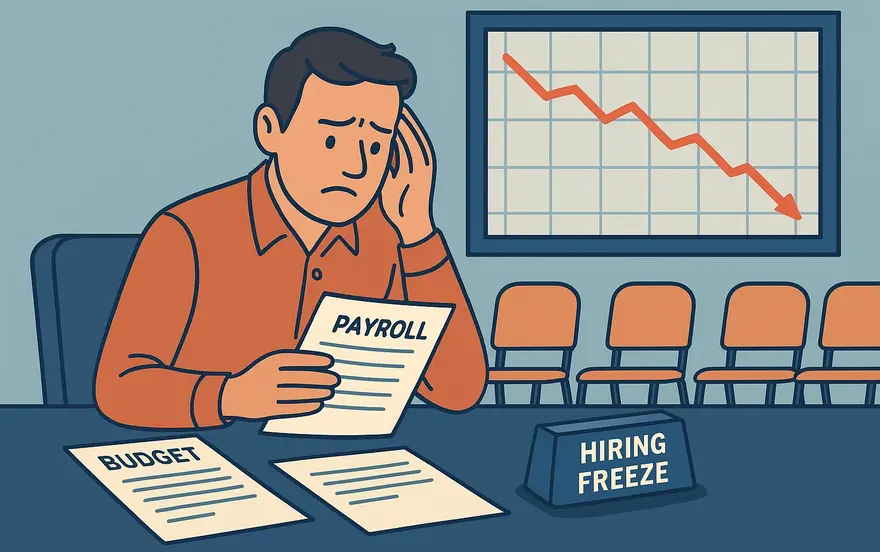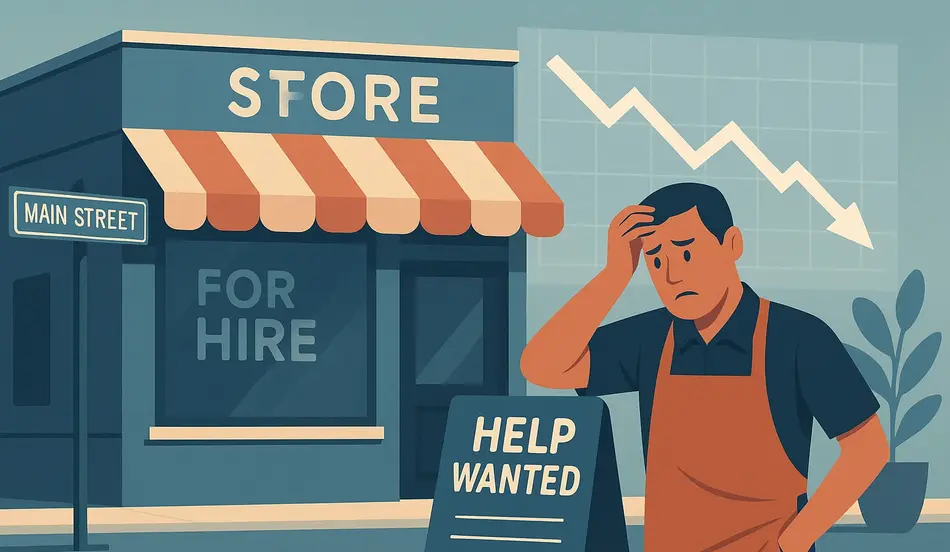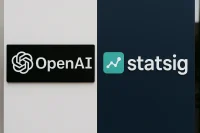Small businesses have long been regarded as the lifeblood of the American economy—employing nearly half of the private workforce and contributing substantially to job creation, innovation, and local development. But in mid-2025, something is shifting. Despite solid consumer spending and historically low unemployment, hiring among small enterprises has slowed sharply. As labor demand cools and growth forecasts dim, many business owners are asking a pivotal question: Is this a short-term stall or a warning sign of deeper economic fragility?
The State of Small Business Hiring in 2025
Recent Trends and Numbers
According to recent reports from the National Federation of Independent Business (NFIB), the number of small firms planning to add workers is at its lowest since early 2020. While nearly 90% of small businesses report job openings, only 41% expect to fill them in the next three months. This hiring hesitancy is a stark reversal from the post-pandemic hiring surge.
In June 2025, the U.S. Bureau of Labor Statistics showed that hiring among small businesses (those with fewer than 50 employees) declined by 0.6% quarter-over-quarter. That may seem modest, but in aggregate it signals a cooling labor appetite—and in some sectors like hospitality, construction, and retail, the drop is more pronounced.
Why Small Businesses Are Pulling Back
A. Wage Pressures
With inflation having eased only slightly from its 2023 highs, wage expectations have remained elevated. Small businesses, often operating on thinner margins, can’t keep up with corporate wage hikes. When major chains offer $22–$25/hour for entry-level roles, small operators in restaurants, home services, or logistics find themselves priced out of the labor pool.
B. Rising Benefit Costs
Healthcare premiums and benefit packages have also surged. According to a survey from the U.S. Chamber of Commerce, nearly 63% of small employers say they’ve had to reduce hiring plans due to health coverage expenses alone.

C. Uncertain Demand
Even though consumer spending remains healthy, small businesses are worried about demand volatility. Owners in retail and professional services cite “uneven monthly sales” and concerns that higher interest rates may eventually curb discretionary spending—making them cautious about bringing on new staff.
D. Tight Credit Conditions
Small businesses are more vulnerable to high interest rates and tightening credit. As the Federal Reserve continues its inflation-fighting stance into 2025, small firms face steeper borrowing costs—limiting their ability to invest in expansion or staff growth.
Who’s Feeling the Pinch?
Industry Breakdown
- Retail: Independent retailers are seeing foot traffic shift to e-commerce giants. Unable to match convenience and discounts, they’re delaying hiring or shifting to gig-based staffing.
- Construction: Small contractors report project delays tied to financing costs, with worker shortages persisting despite demand.
- Hospitality: Many restaurants and cafes report that customer traffic is back, but worker availability and retention remain challenging.
Geographic Differences
Rural and semi-urban regions are especially affected. Businesses outside major metros struggle not just with fewer applicants but also with reduced access to business development services, grants, and hiring subsidies.
Economic Implications
A. National Employment Picture
Small businesses employ around 61 million Americans. Any sustained decline in hiring from this segment could undercut national job growth. Slower onboarding means fewer people earning, spending, and saving—translating into broader economic drag.
B. Innovation and Competition
Small enterprises fuel innovation and provide critical competition to larger firms. Reduced hiring stifles their ability to test new products, expand locations, or compete in new markets.
C. Widening Inequality
The employment slowdowns disproportionately affect younger, less experienced, and lower-income workers—who often depend on small businesses for first-time job access. This dynamic could exacerbate existing socioeconomic divides.
Policy and Market Responses
Government Interventions
To alleviate pressures, federal and state policymakers are exploring several measures:
- Expanding payroll tax credits for firms under 100 employees.
- Broadening access to SBA microloans with lower interest rates.
- Introducing healthcare subsidy offsets tied to new hiring.
Technology Adoption
Many small firms are investing in digital tools and automation to close labor gaps. Cloud-based accounting, scheduling, and even AI-powered customer service tools are helping some reduce labor dependence while maintaining service levels.
Workforce Development
Some local governments have launched training and apprenticeship programs targeting high-demand roles—matching small employers with workers trained in soft skills, customer service, logistics, and light tech.
What Small Business Owners Are Saying
Quotes from the Field
“We can’t compete with Amazon or Target on wages, so we have to hire smarter. But the talent just isn’t there—or it’s too expensive.” —Leah Martinez, boutique retail owner in Arizona
“I want to hire, but the numbers don’t make sense. My margins are squeezed by everything from insurance to interest.” —Daniel Kim, owner of a five-person HVAC firm in Ohio
“I’ve gone from 12 employees down to 7 in two years—not because business is bad, but because growth is too unpredictable.” —Chandra Singh, restaurant operator in New York
The Worker’s Perspective
Employees, too, are feeling the crunch. Jobseekers report sending out 40–60 applications before receiving callbacks, even for part-time or hourly roles. Some are settling for short-term gig work or freelance contracts, which lack benefits and security.
Graduates entering the workforce are increasingly bypassing small employers in favor of corporations that offer clearer career paths and higher starting wages—even if job satisfaction and flexibility are lower.
📉 Small Businesses Are Slowing Hiring — But You Don’t Have to Wait
While many small enterprises are pausing recruitment amid economic uncertainty, opportunity still thrives in key sectors.
Explore high-demand roles in Computer Science, Engineering, Technology, and Research—fields driving resilience and long-term growth.
At WhatJobs, we help you navigate shifting market dynamics and find your next step in industries that continue to hire and innovate.
👉 Browse resilient tech and research jobs today — and move forward with confidence.Long-Term Outlook
A Soft Patch, or Structural Change?
Experts are split. Some argue that 2025’s hiring slump is a natural correction after the pandemic-era hiring boom. Others warn it may indicate a broader restructuring of how small businesses operate and grow—less reliant on labor, more focused on lean operations and automation.
Reimagining the Talent Equation
As small firms adapt, the future may lie in:
- Flexible staffing models that combine part-time, freelance, and automated labor.
- Skill-first hiring that values certifications and experience over degrees.
- Community collaboration, where businesses pool resources for shared benefits like training hubs and benefit programs.
Final Take
The current small business hiring slowdown isn’t just about cautious employers—it’s about a complex mix of rising costs, shifting market expectations, and competitive pressure. While some firms adapt through tech and leaner operations, many remain stuck in a holding pattern.
If unaddressed, the problem could erode a foundational pillar of the American labor market. But with thoughtful policy, technology investment, and workforce development, small businesses can once again become engines of growth and inclusion.
Stay updated on labor trends, policy changes, and employer insights at WhatJobs News.
FAQs
Q: Are small businesses still hiring at all?
A: Yes, but at slower rates. Many are hiring selectively or replacing rather than expanding their teams.
Q: Is AI contributing to the hiring freeze?
A: Partially. Automation is reducing the need for administrative, scheduling, and service jobs—especially in retail and food service.
Q: What can policymakers do to help?
A: Provide affordable loans, tax breaks for hiring, subsidized benefits, and streamlined labor compliance for small employers.
Q: How is this different from large company hiring trends?
A: Large firms continue hiring but with their own slowdown. However, they benefit from deeper reserves, brand strength, and the ability to offer competitive pay and perks.




